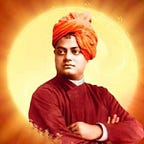What is meditation?
In a lecture delivered at Alameda, California, on 18 April, 1900, Vivekananda told —
What is meditation? Meditation is the power which enables us to resist all this. Nature may call us, “Look there is a beautiful thing!” I do not look. Now she says, “There is a beautiful smell; smell it! ” I say to my nose, “Do not smell it”, and the nose doesn’t. “Eyes, do not see!” Nature does such an awful thing — kills one of my children, and says, “Now, rascal, sit down and weep! Go to the depths!” I say, “I don’t have to.” I jump up. I must be free. Try it sometimes. … [In meditation], for a moment, you can change this nature. Now, if you had that power in yourself, would not that be heaven, freedom? That is the power of meditation.
While discussing Dhyana and Samadhi (Raja Yoga) Vivekananda told —
“When the mind has been trained to remain fixed on a certain internal or external location, there comes to it the power of flowing in an unbroken current, as it were, towards that point. This state is called Dhyana.
These ideas have to be understood in Dhyana, or meditation. We hear a sound. First, there is the external vibration; second, the nerve motion that carries it to the mind; third, the reaction from the mind, along with which flashes the knowledge of the object which was the external cause of these different changes from the ethereal vibrations to the mental reactions. These three are called in Yoga, Shabda (sound), Artha (meaning), and Jnâna (knowledge). In the language of physics and physiology they are called the ethereal vibration, the motion in the nerve and brain, and the mental reaction. Now these, though distinct processes, have become mixed up in such a fashion as to become quite indistinct. In fact, we cannot now perceive any of these, we only perceive their combined effect, what we call the external object. Every act of perception includes these three, and there is no reason why we should not be able to distinguish them.”
When, by the previous preparations, it becomes strong and controlled, and has the power of finer perception, the mind should be employed in meditation. This meditation must begin with gross objects and slowly rise to finer and finer, until it becomes objectless. The mind should first be employed in perceiving the external causes of sensations, then the internal motions, and then its own reaction. When it has succeeded in perceiving the external causes of sensations by themselves, the mind will acquire the power of perceiving all fine material existences, all fine bodies and forms. When it can succeed in perceiving the motions inside by themselves, it will gain the control of all mental waves, in itself or in others, even before they have translated themselves into physical energy; and when he will be able to perceive the mental reaction by itself, the Yogi will acquire the knowledge of everything, as every sensible object, and every thought is the result of this reaction. Then will he have seen the very foundations of his mind, and it will be under his perfect control.
